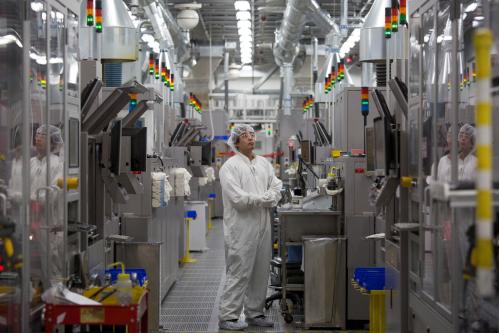For more than 40 years, the Brookings Papers on Economic Activity—the academic journal published twice a year by Economic Studies at Brookings—has been publishing new research from leading economists on the world’s biggest policy puzzles.
Once again, the journal is back with six new papers that include GDP growth projections after the tax bill, an in-depth look at male joblessness, a proposal for restructuring mortgage markets, and more.
You learn more about two major findings below, or read up on the main findings from all six new papers here.
Automation is creating more jobs than it takes—but workers aren’t seeing commensurate wage growth
Using nearly five decades of data from 28 industries in 19 countries, a paper by MIT’s David Autor and Utrecht University’s Anna Salomons examines whether automation is really killing jobs.
The authors find some good news: automation doesn’t reduce the number of jobs available—if anything, it creates them. Although some industries have lost jobs due to automation, the productivity spillovers accruing to customer and supplier industries (what the authors call “the Costco effect”) and to overall consumer spending (what they call the “Walmart effect”) more than offset the direct losses to specific industries. The net effect is a slight increase in employment, cumulating to some 6 percent over the 1970-2007 period.
But here’s the catch: While automation has created jobs, enhanced the size of the economic pie, and increased total worker earnings, it has not raised the share of national income allocated to wages as rapidly as it has raised productivity. In short, the part of the economic pie that belongs to worker earnings has shrunk. This finding holds whether automation is measured by productivity gains, by industry-level patenting flows, or by adoption of industrial robotics. In net, the effect of automation on the share of national income allocated to wages is negative because industry-level loses are not fully offset by either “Costco” or “Walmart” effects.
To learn more, read the full paper.
Less and less safety net spending is going to the poorest children
New research from Hilary Hoynes of the University of California, Berkeley and Diane Schanzenbach of Northwestern University examines what groups of children are served by core childhood social-safety net programs—including Medicaid, EITC, CTC, SNAP, and AFDC/TANF—and how that’s changed over time.
What they find is virtually all gains in spending on the social safety net for children since 1990 have gone to families with earnings. The poorest children, whose parents have no earned income, have seen a decrease in benefits from $48 billion in 1990 to $32 billion in 2015.
Following the reform of the welfare system under President Clinton in 1996, there has been a continued shift in spending toward programs tied to employment and away from traditional out-of-work assistance. Today there is minimal cash welfare spending, and the vast majority of safety net expenditures are distributed via work tax credits, health insurance, and food stamps. As a result, the share of safety net spending on families with incomes below the poverty level has fallen from 86 percent in 1990 to 53 percent in 2015.
The authors emphasize past research illustrating the long-term positive effects of access to social safety net programs in childhood, and suggest these trends put the poorest children at risk of poor health and economic outcomes later in life.
To learn more about new research published in the Spring 2018 edition of the Brookings Papers on Economic Activity, visit the full project page or read summaries of all six new papers here.






Commentary
Robots aren’t taking the jobs, just the paychecks—and other new findings in economics
March 8, 2018